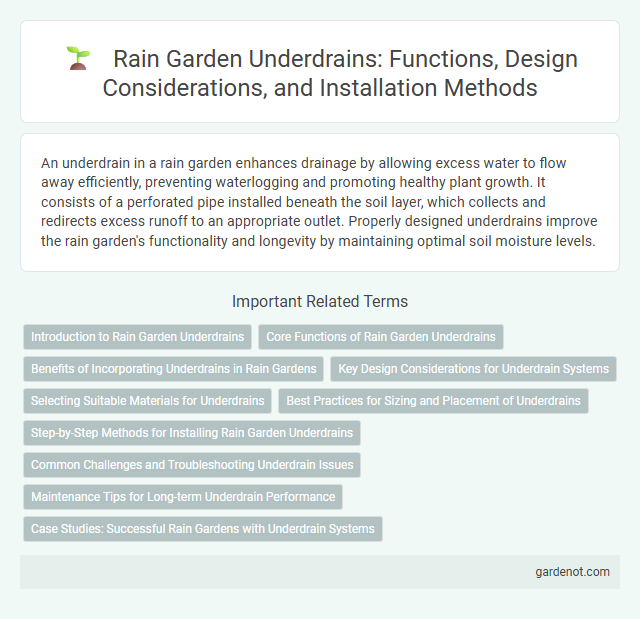An underdrain in a rain garden enhances drainage by allowing excess water to flow away efficiently, preventing waterlogging and promoting healthy plant growth. It consists of a perforated pipe installed beneath the soil layer, which collects and redirects excess runoff to an appropriate outlet. Properly designed underdrains improve the rain garden's functionality and longevity by maintaining optimal soil moisture levels.
Introduction to Rain Garden Underdrains
Rain garden underdrains are essential components designed to enhance drainage in areas with poorly infiltrating soils. These perforated pipes, typically installed beneath the rain garden's soil layer, facilitate the controlled conveyance of excess stormwater to prevent waterlogging and ensure proper soil saturation. Effective underdrain systems improve rain garden performance by promoting efficient water percolation and preventing prolonged surface ponding.
Core Functions of Rain Garden Underdrains
Rain garden underdrains play a crucial role in managing stormwater by facilitating proper drainage and preventing waterlogging in the soil matrix. These perforated pipes or gravel layers beneath the rain garden collect excess runoff, promoting infiltration while protecting plant roots from prolonged saturation. By enhancing subsurface flow, underdrains improve the garden's ability to mitigate flooding, reduce surface runoff pollutants, and maintain optimal soil moisture for vegetation health.
Benefits of Incorporating Underdrains in Rain Gardens
Incorporating underdrains in rain gardens significantly enhances drainage efficiency by preventing waterlogging and promoting rapid infiltration into surrounding soils. These underdrain systems reduce standing water, mitigating mosquito breeding and plant root damage while improving overall garden health. Efficient water management through underdrains supports stormwater control goals by facilitating groundwater recharge and reducing runoff pollution.
Key Design Considerations for Underdrain Systems
Underdrain systems in rain gardens require careful selection of pipe material, typically perforated PVC, to ensure durability and effective water infiltration. Proper sizing of the underdrain pipe and gravel bed is crucial for optimal drainage capacity, preventing waterlogging and promoting soil saturation balance. Positioning the underdrain above the impermeable layer enhances water filtration while maintaining structural integrity against soil compaction.
Selecting Suitable Materials for Underdrains
Selecting suitable materials for rain garden underdrains involves choosing permeable and durable options such as perforated PVC or corrugated HDPE pipes, which facilitate efficient water drainage and prevent clogging. Incorporating clean, washed gravel or crushed stone around the underdrain pipes ensures optimal filtration and structural stability, enhancing long-term performance. Proper material selection directly impacts the rain garden's ability to manage stormwater runoff and supports healthy soil moisture levels.
Best Practices for Sizing and Placement of Underdrains
Proper sizing and strategic placement of underdrains in rain gardens are critical for effective stormwater management and soil saturation control. Underdrains should be sized based on the watershed area, soil infiltration rates, and anticipated flow volumes, typically designed to handle peak flow within 24 to 48 hours to prevent prolonged saturation. Positioning underdrains at the lowest point of the rain garden with appropriate gravel envelopes ensures optimal drainage while maintaining the health of surrounding vegetation and preventing groundwater contamination.
Step-by-Step Methods for Installing Rain Garden Underdrains
Begin by excavating the rain garden area to the specified depth, ensuring a level base for proper drainage. Install a perforated PVC pipe wrapped in landscape fabric, positioning it at the lowest point of the garden to collect and redirect excess water. Cover the pipe with a layer of clean, coarse gravel before backfilling with engineered soil mix to promote infiltration while preventing clogging.
Common Challenges and Troubleshooting Underdrain Issues
Underdrains in rain gardens often face challenges such as clogging from sediment buildup, which can impede proper drainage and cause water pooling. Troubleshooting includes inspecting and cleaning the perforated pipe regularly, ensuring the gravel layer around the underdrain is free of fine particles, and verifying that the outlet remains unobstructed to maintain efficient water flow. Proper installation with appropriate filter fabric and routine maintenance reduces common issues related to underdrain performance.
Maintenance Tips for Long-term Underdrain Performance
Regular inspections of underdrains in rain gardens ensure efficient water flow and prevent clogging by removing accumulated debris and sediment. Flushing the system with clean water periodically helps maintain permeability and reduces the risk of blockages. Installing accessible cleanouts simplifies maintenance and prolongs the longevity of the underdrain system.
Case Studies: Successful Rain Gardens with Underdrain Systems
Case studies of successful rain gardens with underdrain systems reveal improved stormwater infiltration rates and reduced surface ponding in urban settings. Projects in Portland, Oregon, demonstrate that underdrain installations enhance soil moisture regulation and prevent waterlogging in heavy clay soils. These systems consistently support healthier vegetation and increased pollutant removal efficiency, showcasing effective design integration for sustainable stormwater management.
Underdrain Infographic

 gardenot.com
gardenot.com